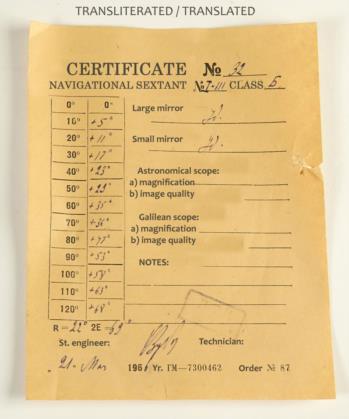
NavList:
A Community Devoted to the Preservation and Practice of Celestial Navigation and Other Methods of Traditional Wayfinding
From: Frank Reed
Date: 2023 May 26, 08:18 -0700
Here's a Russian sextant certificate from the 1960s. The sextant may have been a vernier sextant from the 1920s. The pattern of the errors is interesting. Apart from one little bump, which may have been an error in the calibration process instead of the sextant, it's almost perfectly linear, and actually just proportional. The error in seconds of arc can be modelled as 57.5% of the observed angle in degrees. Equivalently, if we want the error in minutes of arc, that's 0.96% of the angle in degrees. Or if we want it without any units (equivalent to degrees per degree), then the error is 0.016% of the observed angle:
(sextant angle) = 1.00016 · (true angle).
This relationship on a vernier sextant suggests a simple interpretation: the scale is simply enlarged, swollen; it's fat (by 0.016%).
Something I couldn't figure out: at the bottom of the calibration column, it says "R=22° 2E=69°". Any thoughts? Maybe a standardized eccentricity model??
Frank Reed
Clockwork Mapping / ReedNavigation.com
Conanicut Island USA









